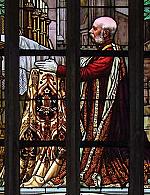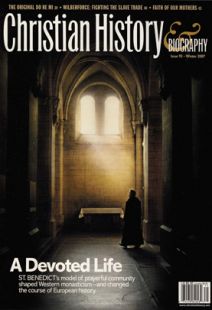Christian History Timeline: Benedict and the Rise of Western Monasticism
The Rise of Western Monasticism—250–
c. 280s Antony withdraws to the Egyptian desert
312/313 Constantine becomes a Christian; Edict of Milan calls for persecution of Christians to end
c. 320 Pachomius, founder of cenobitic (communal) monasticism in Egypt, receives his first disciples
325 Council of Nicaea approves creed proclaiming that Christ is divine in the same way as the Father
356 Antony dies; Athanasius, bishop of Alexandria, writes The Life of Antony
370 Basil the Great, monastic founder in Cappadocia, becomes bishop of Caesarea; he writes principles of ascetic life
early 370s Semi-hermits gather around Martin of Tours in Gaul; he later establishes a monastery that eventually becomes Benedictine
374 Melania the Elder establishes a monastery of women in Jerusalem; Rufinus follows in 380 and establishes a monastery of men
385 Jerome leaves Rome to follow monastic life in the East; his colleague Paula follows soon after
386 Augustine reads Latin translation of The Life of Antony and converts to Christianity soon after
c. 395 Paulinus removes to Nola, where he leads an ascetic life
404 Jerome translates rules of Pachomius into Latin
407–8 Destruction of Scetis, major center of hermits in Egyptian desert
410 Fall of Rome (city sacked by Goths)
410 Cassian writes Conferences in Latin, allowing Westerners to read about Eastern monastic traditions
The Rise of Western Monasticism—450–
451 Council of Chalcedon defines the two natures of Christ
455 Rome sacked again by Vandals
476 Romulus, the last Western Roman emperor, deposed by barbarian leader Odoacer
c. 480 Benedict is born in Nursia, Italy
489 Theodoric the Great, king of Ostrogoths, invades Italy and deposes Odoacer
c. 493 Benedict leaves Nursia to study in Rome
c. 502–505 Benedict lives as a hermit in a cave
c. 507–529 Benedict builds 13 monasteries
526 Theodoric dies, opening Italy to more invasions
c. 529 Benedict moves his monks to Monte Cassino
c. 530 Benedict writes his Rule
540 Gregory (the Great), Benedict’s first biographer, is born
547 Traditional date of Benedict’s death (March 21)
558 Abbey of Germain-des-Pres founded in France
563 Irish missionary monk Columba goes with 12 companions to Iona, Scotland; Celtic Christianity spreads to Scotland and other Anglo-Saxon territories
568 Lombards invade Italy
c. 580s Monte Cassino is destroyed by Lombards; monks flee to Rome, carrying a copy of Benedict’s Rule
590 Gregory, by now a Benedictine monk, becomes pope (reluctantly)
c. 590 Irish missionary monk Columbanus leaves Ireland for Gaul; later writes rule at Luxeuil, one of the Celtic monasteries that he established in the region
593 Pope Gregory writes Dialogues, including account of Benedict’s life
597 Pope Gregory sends Augustine of Canterbury as missionary to England
629–670 Abbacy of Walbert of Luxeuil, who ushered in the period of “mixed rules” in Gaul by combining Columbanus’s Rule with Benedict’s
632 Mohammed dies in Mecca
The Rise of Western Monasticism—650–
663 Synod of Whitby convenes to work out conflicts between Celtic and Roman Christian practices in England; decides in favor of Roman practices, including date of Easter
680 Bede enters the cloister at Jarrow, England
c. 696 Rupert of Worms founds St. Peter’s Abbey in Salzburg as part of mission to the South Alps
c. 717 Monte Cassino is refounded; revives observance of Benedict’s Rule in Italy
720s English missionary monk Boniface sets up monastic foundations in present-day Germany
731 Bede completes Ecclesiastical History of the English People
782 Charlemagne, King of the Franks, invites Alcuin to lead palace school, where he teaches the seven liberal arts
800 Charlemagne crowned emperor by Pope Leo III
c. 800 Anskar, “apostle to the Scandinavians,” is born; enters monastery of Corbie as a youth
c. 800 Celtic monks at Iona and Kells, Ireland, illuminate the four gospels in the Book of Kells
803 Charlemagne tells bishops to develop schools for church music
806 St. Columba’s monastery at Iona destroyed by Vikings; all monks are killed
814 Charlemagne’s son Louis the Pious begins reign
814 Synods of Aachen aim to have all monasteries follow Benedict’s Rule; Benedict of Aniane is the abbot general
819–826 The Plan of St. Gall, a schema for an ideal monastery that influences future monastic architecture, is created at the monastery of Reichenau.
826 Anskar arrives in Denmark
The Rise of Western Monasticism—850–
863 Cyril and Methodius, Byzantine Christian brothers, go to Moravia as missionaries and help convert the Slavs (Cyril was an Eastern Orthodox monk)
883 Monte Cassino burned to the ground in Muslim invasions
909 Duke William of Aquitaine founds monastery of Cluny
c. 930-931 Abbot Odo of Cluny writes The Life of St. Gerald of Aurillac
950 Conversion of Queen Olga of Russia
968 Vikings occupy Santiago de Compostela in Spain
1012 Italian monk Romauld founds Camaldolese order, which follows Benedict's Rule
The Rise of Western Monasticism—1050–
1054 Schism between Eastern and Western church
1066 William the Conqueror takes England
1084 French cleric Bruno founds the Carthusian order, combining communal and solitary forms of monastic life
1093 Anselm, monk of Bec, becomes Archbishop of Canterbury
1095 Pope Urban II proclaims the first Crusade
1098 Monastery of Cîteaux founded, marks beginning of Cistercian order in Burgundy
1112 Bernard of Fontaine enters Cîteaux with 30 noblemen, reinvigorating the Cistercian order; he later founds a monastery at Clairvaux
1122 Peter the Venerable becomes abbot of Cluny
1139 Peter the Venerable visits Spain; has Qur'an translated into Latin
1141 German Benedictine abbess, mystic, musician, and preacher Hildegard von Bingen begins to record her visions
c. 1170 Dominic born in Castile
1181/1182 Francis of Assisi born
1203–1206 Dominic begins to formulate his idea for an order of preachers
1212 Clare of Assisi begins the Poor Clares after hearing Francis preach
1215 Innocent III declares no new monastic rules are to be approved
1221 Dominic dies
1226 Francis dies
By compiled by Antonia Ryan with contributions from Carmen Acevedo Butcher
[Christian History originally published this article in Christian History Issue #93 in 2007]
Next articles
Editor's note: The World Wars
Heroic, fascinating, and troubling stories from the great wars
Jennifer Woodruff TaitThe crisis of the West
World Wars I and II proved to be more than a political crisis: they were a spiritual one
Jeffrey B. WebbSupport us
Christian History Institute (CHI) is a non-profit Pennsylvania corporation founded in 1982. Your donations support the continuation of this ministry
Donate






